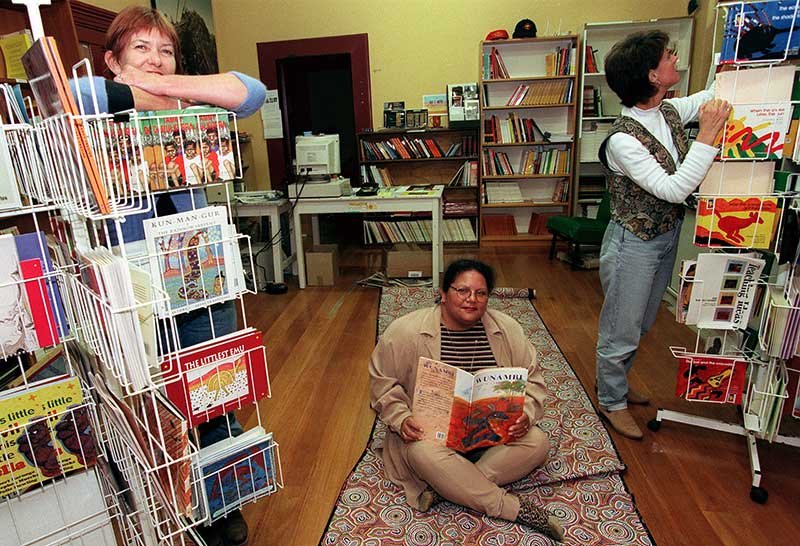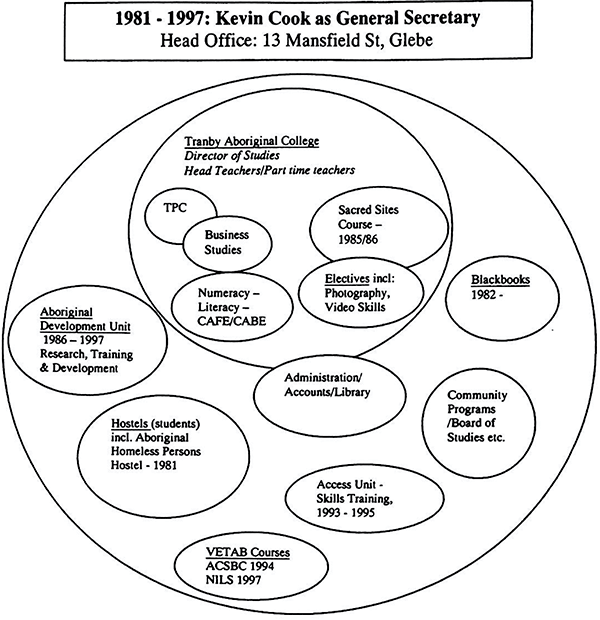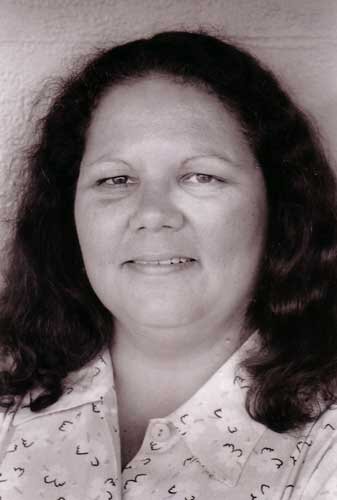LEARNING IN GLEBE
Courses
The range of courses offered at the Glebe site developed over time. The diagrams by archivist Julia Mant show the way the courses at Glebe changed over time.
When the Co-operative began in 1957, Alf Clint established the Tranby site as a hostel for young people from rural co-operatives so they could stay there while they did apprenticeships. These co-operatives were on Moa Island (in the Torres Straits), at Lockhardt River, Clump Mountain and Yarabah (all in North Queensland) and at Cabbage Tree Island, in the Richmond River near Lismore in NSW. From 1960, Summer Schools were offered on cooperative management and organisational strategies. From 1962, short but ongoing courses were offered for cooperative members including bookkeeping skills.
Under Kevin Cook as General Secretary, from 1981 to 1997, Tranby developed new courses as it responded to student interests, drawing on expanded Federal funding environments after the Federal Australian Labor Party (ALP) had been in power in the early 1970s and the State ALP held power in NSW during much of the 1980s.
Kevin Cook and Tranby remained committed, however, to education in the community and there were many courses run, often through the ADU, with learners from communities and teaching staff either recruited from community elders or from Tranby teachers. See the Learning in Community section for the NOW! Course and the Learning on the Job section for the Boomerang Factory and the ADU.
Diagram showing courses offered under Kevin Cook, 1981-1997. Diagram by Julia Mant
Funding
Before 1980, under Alf Clint’s direction, all the funding for Tranby Co-op came from supportive unions and the Australian Board of Missions. After 1980, when Kevin Cook became General Secretary, a more supportive Commonwealth Department of Education – ComEd – funded Tranby for some teaching staff, while students could access AbStudy scholarships for their living expenses, a crucial need for adult students. All other costs – like administrative staff and running costs – came from unions like the Maritime Union (formerly the Australian Seamen’s Union and the Waterside Workers Federation).
The Business Studies course, with some students shown here including Ruth de Costa, allowed Tranby to continue to teach about cooperatives but to include as well issues around company law and management strategies. Ruth later coordinated the ADU. Source: Tranby Archives
In the mid-1980s, under Neville Wran’s State Labor Government, the Technical and Further Education Department (TAFE) began to fund whole courses – that is, not only teaching staff but running costs. But Tranby found this led to unwanted controls over their teaching methods and course content. Kevin explained this in conversation with Chrissie Kerr, who became Tranby office manager and teacher in the early 1990s:
Cookie - We’d have someone come out and tell us how we had to teach the course, and we refused to do that. And they all went “If you don’t do it this way, then you don’t get any money.”
So we were always under the strap of, you know, conforming to their way of thinking and it wasn’t Tranby’s way of thinking!
We decided that the only way out of it was to get out of TAFE funding. And so that we had to design our own courses and get them accredited through VTAB (Vocational Education and Training Accreditation Board) and that meant bringing in new people, looking out for new money.Chris - Yeah, it was an irony! Kim McConville was employed through Tranby to pull together the Advanced Diploma of Applied Aboriginal Studies and she had done a great job. You had all of these Elders involved, everybody working with Kim on getting the content right and the delivery structure of it right. I remember Aunty Is (Isabel Flick) saying, ‘We want this to be delivered!’.
And then the first time it went up to VTAB, they didn’t accredit it! They said “No, no, you know it has to look like this and behave like this!’
It always struck me so extraordinary that a non-Aboriginal bureaucracy would say “That’s inappropriate.”
But Kim reworked it in such a way to still maintain the integrity of it, but to get it through VTAB!’- Kevin Cook talking with staff member, Chrissie Kerr, 4 Sept 2005
Gallery - Office and support staff
Some of the office and support staff who worked at Tranby with Kevin Cook, including Regi Choolburra who passed away suddenly in 1982. All photos from Tranby Archives.





Gallery - Teachers
Some of the teachers at Tranby and at community learning centres from 1981 to 1997, including Directors of Study Brian Doolan, Helen Corbett (prev Boyle), Alan Lui, Oomera Edwards, Yvonne de Vries and Josephine David-Petero, as well as teachers and coordinators Terry Widders, Chris Milne, David Morrissey, Paula Ware, Robyn Ridgeway, Kerry Ferguson, Para Seneviratne (or, more briefly, Para Sene) and Cathy Craigie (first a student and later a teacher). All photos from Tranby Archives.









Electives at Tranby were held at various times in skills like typing; in media production, like the 1985 collaboration with UTS to produce The Meeting Tree, the Tranby Newsletter; in image work (see Pictures Tell Stories) and with many excursions to allow students to learn from community elders and in community settings (see the Learning in Community section).
View 1985 NSWIT Link-Up Course, an elective in production in collaboration with NSW Institute of Technology (later UTS) staff. Source: Tranby Archives



From 1998, Jack Beetson became Executive Director at Tranby. A number of courses were consolidated into a smaller number which could be accredited by formal NSW Education. NILS, the National Indigenous Legal Studies unit, arose from a recommendation of the Royal Commission into Aboriginal Deaths in Custody. This diagram shows the resulting structure at Tranby from 1998 until c2005.
Diagram showing Tranby courses and structure under Jack Beetson from 1998 to c2005. Diagram by Julia Mant
The group photo of all Tranby staff in 1990 shows many of the people who worked in the office, in teaching and in building maintenance over the period on which this site is focussed, from 1980 to 2000.
Tranby staff in 1990, including Para Seneviratne (standing on left), Kevin Cook (kneeling on left), then Robert Stanley and Lorelle (kneeling and seated next to Kevin). Among those at rear are Josephine David-Petero, Cathy Craigie and Ruth de Costa (all three standing in centre) then Albert Williams, Jack Beetson and Gavin Flick, (all three standing on right). Source: Tranby Archives









